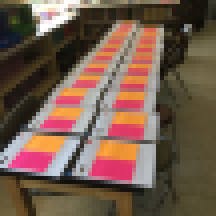Today was the day. I was about to utter the dreaded words “peer editing.” As I began class with my eighth graders, I told them we would be editing each other’s research papers during our double class period. The reactions included the predictable eye rolls, heavy sighs, and for some, visible panic.
We’d done this before—but what they didn’t know was that this time we were going to edit each other's work anonymously. As soon as I mentioned that word, “anonymously,” the mood in the room shifted and students sat up a bit straighter in their seats. I began feeling optimistic.
I teach middle school English Language Arts at St. Joseph School in Chester County, Pa. Like most schools, we serve students with a range of abilities. Peer editing here usually consists of working with partners, swapping writing assignments and making suggestions. But over time I’ve found many middle schoolers are not equipped to critique an essay that meets the expectations of the assignment.
One student, Colleen, became agitated each time I mentioned that we would be reading each other’s writing. She was a competent writer, but was always stressed out about big assignments, especially when it came to writing. She would check in with me frequently and ask if she was on the right track. I would encourage her to write more than one paragraph before coming to me, but she needed feedback constantly, and would apologize each time she came to my desk. While we all face stress on occasion, this is not how I wanted my students to feel about writing.
There are some challenges that students face when they first encounter peer editing. They don't really know how to comment on each other’s work, and they do not always know what to look for to help their partner create a better paper. Also, they really do not want to edit their own work. The research and writing process is lengthy, and once completed, they just want to hand in their papers, not revisit them again.
As a teacher, I share some of their frustrations. The writing process is indeed long, and to spend time on editing creates pressure, especially when there is so much material to cover. I also grapple with the cultural obsession with technology. Students in our school are not allowed to have their phones in class; however, outside of school, social media is a big part of their lives. They do not have to look at each other, or even verbally speak to each other. The ability to properly communicate and collaborate is a skill that needs to be preserved and fostered. I knew I had to find a solution.
Our research paper is written in March. To give students a wide range of topics, we use the Billy Joel song “We Didn’t Start the Fire.” The lyrics span the decades from the 1940s through the 1980s, and students choose one topic from the lyrics—anything from McCarthyism to Vietnam to the Pepsi-Coke cola wars—to research and write a five-page paper on, using MLA format.
Since students don’t intuitively know how to craft good feedback, this was the natural place to start. I wanted to hone their ability to respond to each other, both positively and constructively. I gave students a few weeks to research their topics then posed a simple question on Google Classroom: “What do you think of the process so far, and are you happy with your topic choice?”

To break the ice, I responded to the question myself, giving students sample language that they could use. I told them their response could be either positive or negative, but it had to be worded appropriately. Many were encouraging. One student wrote, “I love my topic and it’s really easy to find information on it.” Another noted, “My topic is interesting, but I’m having trouble finding good information, and I don’t know how to look for it.”
Not every response hit the mark. In particular, some students still struggled with replying to peer comments, writing things like, “I don’t know why you can’t find information. Just Google it.” After the feedback was in, we looked at the responses as a class and highlighted the ones that were particularly helpful. After two weeks, their written feedback improved dramatically, and so did their interactions with each other.
Finally, the big day had arrived. The papers were typed and printed out. When the students walked into the room, the papers were laid out on the back table with numbers and two giant sticky notes on them. That’s when I told them they would be peer editing, and their faces began to fall. Then I explained the anonymous factor.

All names on the papers were covered with washi tape, which is easily removable. Students would choose a random paper to read. They could write on it to correct any mistakes they encountered. On the pink sticky note, they would write two things they liked about the paper. On the orange note, they’d write two things they felt needed improvement. Once finished, they returned the paper to its numbered spot on the table and took another, so that every student read and commented on two papers.
I must admit that there was an air of excitement in the room. We had never tried this before, and they were eager to get started. Colleen, my anxious student, asked, “You mean no one will know I read their paper, and I won’t know who read mine?” I told her yes, and she relaxed considerably. The whole class did.
It was validating to see students working so hard, and reading so carefully. Even the students who struggle in language arts, and perhaps could not provide polished grammatical corrections, were enthusiastic and on-task with their positive and constructive comments. The students could not wait to get their papers back and read what their peers had written. (Colleen, especially, tore through the pages of her paper looking at the suggestions.)
Students were given a week to revise and edit their papers based on the suggestions they received from their peers. The activity had a profound effect on their final work. Since the original drafts were turned in to Google Classroom, I was able to compare them to the finished product. Many students had made a real effort to make their papers better. The students talked positively about the experience and even asked if we could do it again.
Of course, there’s always room for improvement. Some students told me they would have liked more time to read a third paper, which I may try moving forward. Others said they didn’t really know how to incorporate the feedback into their papers. In the future, I plan to try some small group meetings to help them figure out where to make their changes, or I may ask proficient writers to be my assistants in helping those who need it.
It is a good day for a teacher when students feel a sense of satisfaction about their work, and take their feedback seriously. Now, the process evokes curiosity and excitement—not dread. And that is how I want my students to feel about writing.


